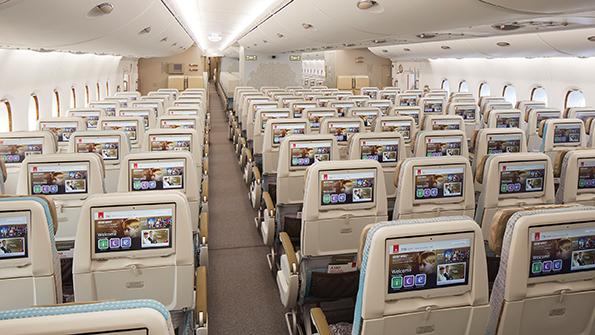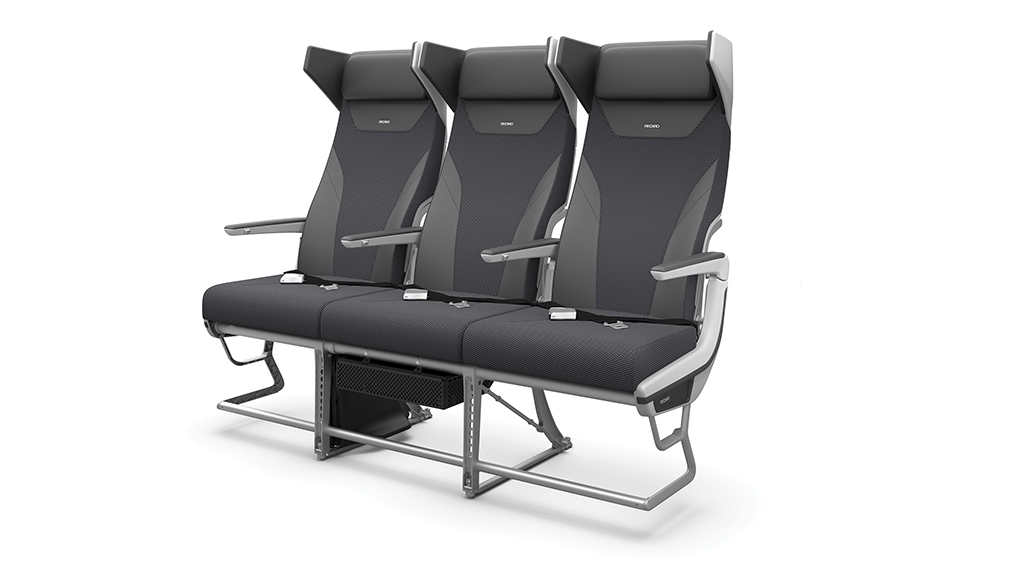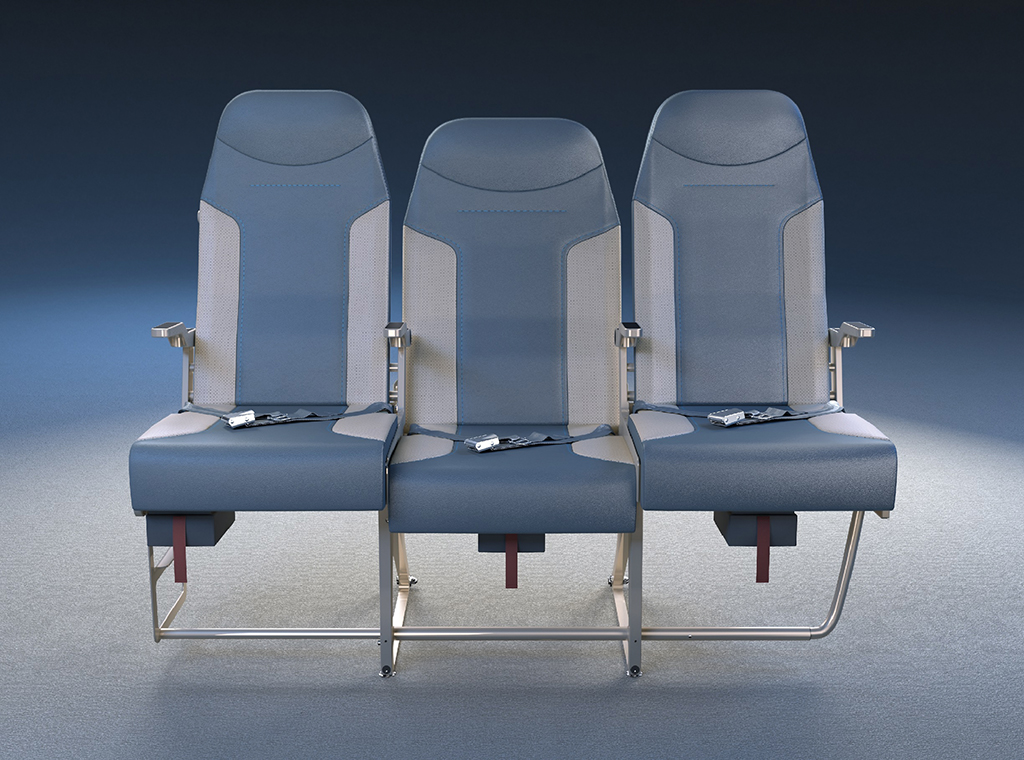
Emirates’ multibillion-dollar interior refurbishment program includes economy seating in Airbus A380 and Boeing 777 aircraft.
As airlines compete for market share, more attention is finally being paid to the economy cabin, with enhanced and lighter-weight seating as a focal point.
Mark Hiller, CEO of Recaro Aircraft Seating and Recaro Holding, explains that for legacy carriers, economy cabin seating is now “all about enhanced comfort and pitches,” in contrast to the low-cost carriers that favor high-density layouts. “Along with greater comfort, other features include connectivity capabilities, including USB integration, and personal electronic device holders, as well as lightweight ancillary revenue features and stowage options for personal belongings,” he says.

Recaro’s CL3810 seat, which entered service for the first time this year, was designed to offer “next-level ergonomics,” Hiller says. The seat, he points out, offers “comfort cushions,” cabin configuration flexibility for wide- and narrowbody aircraft, up to 7 in. of recline and inflight entertainment (IFE) integration capabilities with 12-13-in. screens. “When compared to its predecessor, the CL3710, the seat’s design is 1.5 kg (3.3 lb.) lighter, [and] gives passengers an extra inch of additional knee space, a higher backrest and seat bottom articulation,” he says.
Hiller also sees fixed recline as a coming trend, eliminating the intrusion of a reclined seat in front of the passenger. “Another benefit is a lower total cost of ownership due to fewer moveable parts, resulting in improved reliability and simplified maintenance,” he says. “With no recline mechanism, there is lower weight and cost.”

Along this line, Molon Labe Seating has introduced its S1 seat as a pre-reclined product fixed at 104 deg. “Pre-reclined seats are emerging, particularly in the short-haul airline market, where an adjustable reclining seat is not that essential,” says Hank Scott, CEO of the Denver-based company, which concentrates solely on the coach cabin seating market. “For the airline, the only maintenance involves the fabrics and cleaning.”
By design, the S1 is focused on three areas—pressure/temperature distribution, the seat pan and overall seat width—to maximize passenger comfort within the typical coach cabin’s constrained space, Scott says. “Pressure and thermal distribution, generated by the passenger when seated, can be addressed by the pan height and width, [and] ultimately boils down to comfort,” he explains.
Available in shipsets of three seats each, the individual seat pan heights are 16.1 in. for the middle seat, with pan heights of 17.2 and 18.3 in. for either the aisle or window seat. “We can alternate between the window seat being the highest or the aisle seat being the highest for each alternating row, to give passengers an aisle or window preference based on their sitting height,” Scott explains. “The middle seat is the lowest—for now—but 5 in. wider at the shoulders.”
Though certified in 2019, the pandemic derailed the S1’s entry into service with a launch customer. However, Scott stresses that Molon Labe remains poised to manufacture the S1 immediately upon order.
Molon Labe is also in the process of developing its S2 seat for the long-haul market. With certification slated “within the next two years,” Scott says the project is 65% complete. He adds that one of its unique features will be a patented asymmetric recline.
“You will be able to recline to either your left, right or both sides to improve comfort on long-haul flights,” says Scott. “Also, we are looking at seat pan and lumbar adjustments, and the incorporation of smart materials, which can be actuated by weight/pressure, electricity, heat and other manners. It will have no mechanically actuated parts.”
Jean-Christophe Gaudeau, vice president of marketing at Safran Seats, emphasizes that “space is a key comfort factor,” so optimizing seat structures, such as by reducing thickness, are major considerations. He cites the OEM’s Z200 seat as an example of a product designed for the coach passenger’s comfort.
“The starting point of the Z200’s architecture was living space and comfort,” he says. “Beyond improving the living space, features that can enhance the ability to better rest and sleep in economy seats are another target in terms of passenger comfort.” As an example, he cites the “U-Dream headrest” introduced as an option and available across Safran’s range of economy seats.
Gaudeau also stresses the importance of incorporating lighter-weight designs, especially for economy-class seats. For example, he says the Z400 and Z200—Safran’s latest generation of coach seats—are 30% lighter than those it delivered at the start of the previous decade. Weight reduction, he points out, has been achieved “due to a combination of further mechanical optimization, the use of lighter materials and product simplification.
“In addition, the seats have been designed for greater maintainability through ease of access and [fewer] parts,” he adds.
As for nonreclining seats, Gaudeau reports that while this is “not necessarily a trend,” there is a definite part of the market favoring no-recline seating on narrowbody aircraft. “This type of design is most popular among low-cost airlines that operate typically 1-2 hr. flights. They appreciate the efficiency it brings to their operations in terms of simplicity, use of space and weight benefits, while still delivering adequate comfort for such flights,” he says.
David Pook, vice president of customer experience at Burrana, an Australia-based IFE and cabin technology solutions company, says more economy seats—even those installed by narrowbody low-cost carriers—are being designed to accommodate IFE interfacing with personal electronic devices (PED) to offer inflight connectivity or streaming entertainment via wireless IFE, as well as the ability for passengers to charge multiple devices during the flight. Pook says this includes the flexibility to allow the mix and match of USB-A 15-watt, USB-C 60-watt and 110-volt AC power in the front of the cabin, with USB offered in economy. “Also, we are working with several seat suppliers to pre-integrate our RISE power solution [into] their economy seats,” he says.
In addition, Pook says airlines expect today’s seats to be lighter-weight, sustainable and well-designed to meet their goal of reducing CO2 emissions through the reduction of fuel burn. “They also want greater flexibility for reconfiguration with lighter-weight and highly modular seats,” he says. “As a supplier supporting this ethos, we have designed our in-seat power solution with a unique architecture allowing us to use fewer and smaller units, and smaller connectors, to reduce weight. These lightweight seat components remove the need to perform dynamic seat testing or seat recertification, which reduces lead times, directly benefiting supply chain efficiency goals.”
Pook cites Burrana’s RISE in-seat power solution as an example. “The low-weight [line replaceable units], which are as small as an iPhone, have been designed to fit within the free space of the seat leg housed within a seat spar kit,” he says. “This removes the need to encroach on the passenger space.”
The RISE power architecture has also been designed for easy in-seat line replaceable unit access, with cabin distribution components above the floor, eliminating underfloor power boxes. Pook says other features include a centralized pin in the USB-A jacks, enabling users to insert their PED charging cables correctly 100% of the time, minimizing passenger-induced damage.
“Feature-rich usage data is another unique feature of RISE power, collecting time connected/disconnected and power consumed from each port,” Pook adds. “This allows airlines to better understand passenger usage and behavior by cabin class and route so they can better plan and deliver what is most valued by their passengers. It also provides system performance data, enabling ground staff to better assist maintenance personnel to identify potential faults before [they are] reported by a passenger.”
The biggest challenge from a design perspective is to create the lightest possible seat with improvements to comfort, according to Jo Rowan, associate director of strategy for design company PriestmanGoode. “Light weight is key and has been the immediate focus as the industry works toward net-zero [emissions],” she says. “Generally, all parts and materials are being reconsidered from a weight perspective.”
Rowan says this optimization is being achieved by “questioning” each component. For example, she explains that the thickness of seats can be reduced by using superthin foams or air cushions. Weight can be reduced further by incorporating honeycomb structures, textile applications and materials such as carbon fiber. “Innovative processes such as additive manufacturing and technology are also contributing,” she says.
PriestmanGoode adopted a weight-reduction and comfort enhancement strategy in its recent partnership with Italian seat manufacturer Geven for its Elemento seat series, with applications to both long- and short-haul economy markets. The approach included an adjustable privacy headrest and a patented “wave system” seat form that offers additional comfort while meeting the weight reduction goals. The seat family also incorporates the latest IFE monitors, along with PED holders and adequate stowage.
However, Rowan cautions that lightweight seat designs cannot be adopted at the expense of longevity. “We hear of examples where lightweight alternatives don’t [have] the same lifespan, which is typically 5-7 years,” she says. “Clearly that’s more wasteful overall, so the consideration of material and structures needs to be strategic and long-term.”
Along with lighter weight, Rowan says PED connectivity inclusion in economy seats is now an expectation instead of a “nice-to-have” feature. However, she notes that this also raises sustainability issues.
“The evolution and obsolescence of charge points is contributing to waste, which means we need a collective effort toward a single source for reductive design,” Rowan says. “In our Pure Skies interior concept, we questioned whether IFE screens could be removed altogether in favor of the passengers’ own devices or borrowed screens, with the goal of saving weight. But there’s definitely a mixed view on this, with many airlines wedded to their IFE services from a revenue and communications perspective.”
In the meantime, retrofit programs—including for the economy cabin—are in progress. For instance, Dubai-based Emirates, has launched a multibillion-dollar total cabin refurbishment program on 67 Airbus A380s and 53 Boeing 777s. Company sources confirm that Emirates Engineering will work on the economy seats, which will be completely reupholstered with new covers and cushioning to maximize comfort, as part of what the airline says as its “ongoing commitment to enhance the flying experience.” The refurbishment program, which commenced in August 2022, is slated for completion in 2025. More than 24,000 economy seats on the A380s and 13,000 on the 777s will be totally refurbished.

